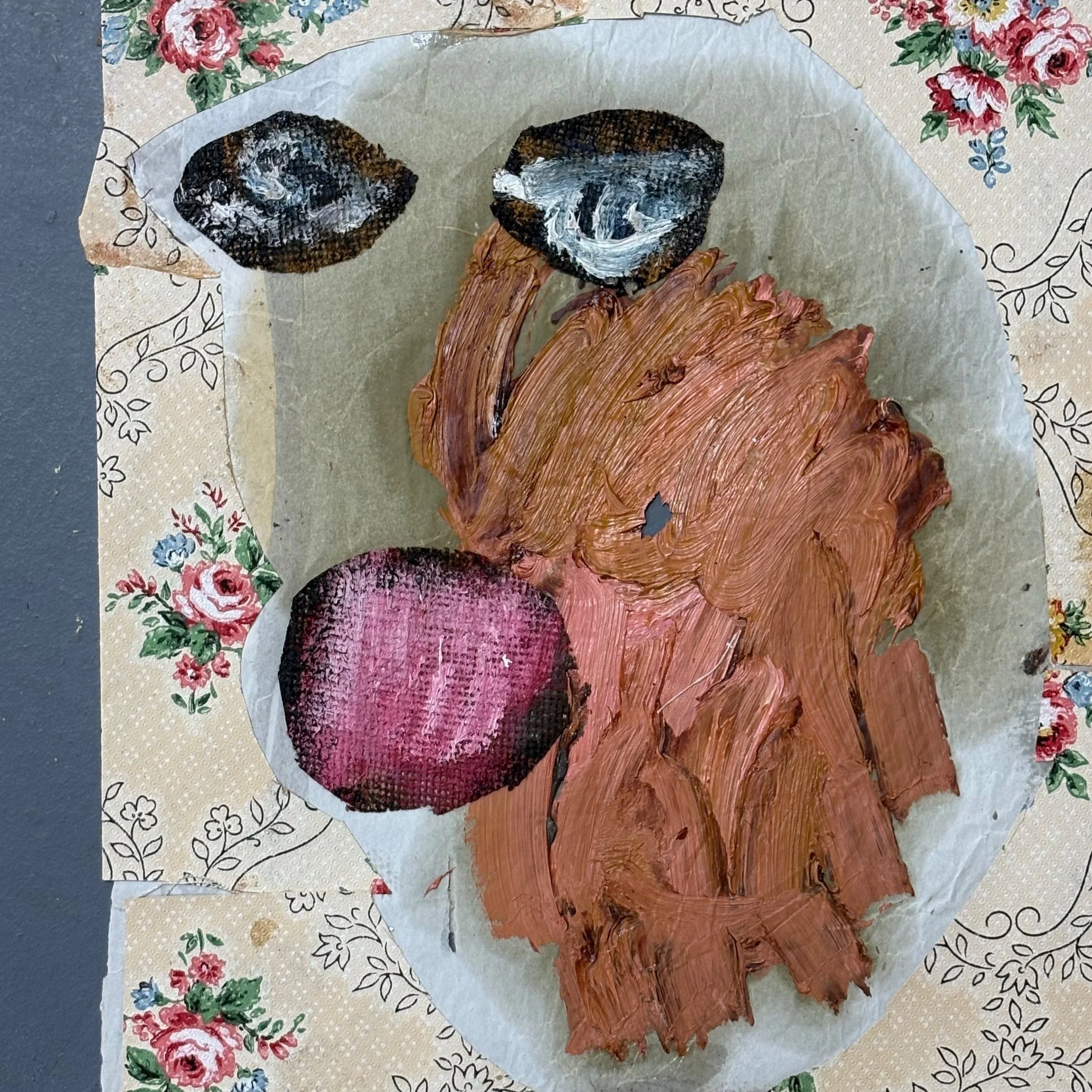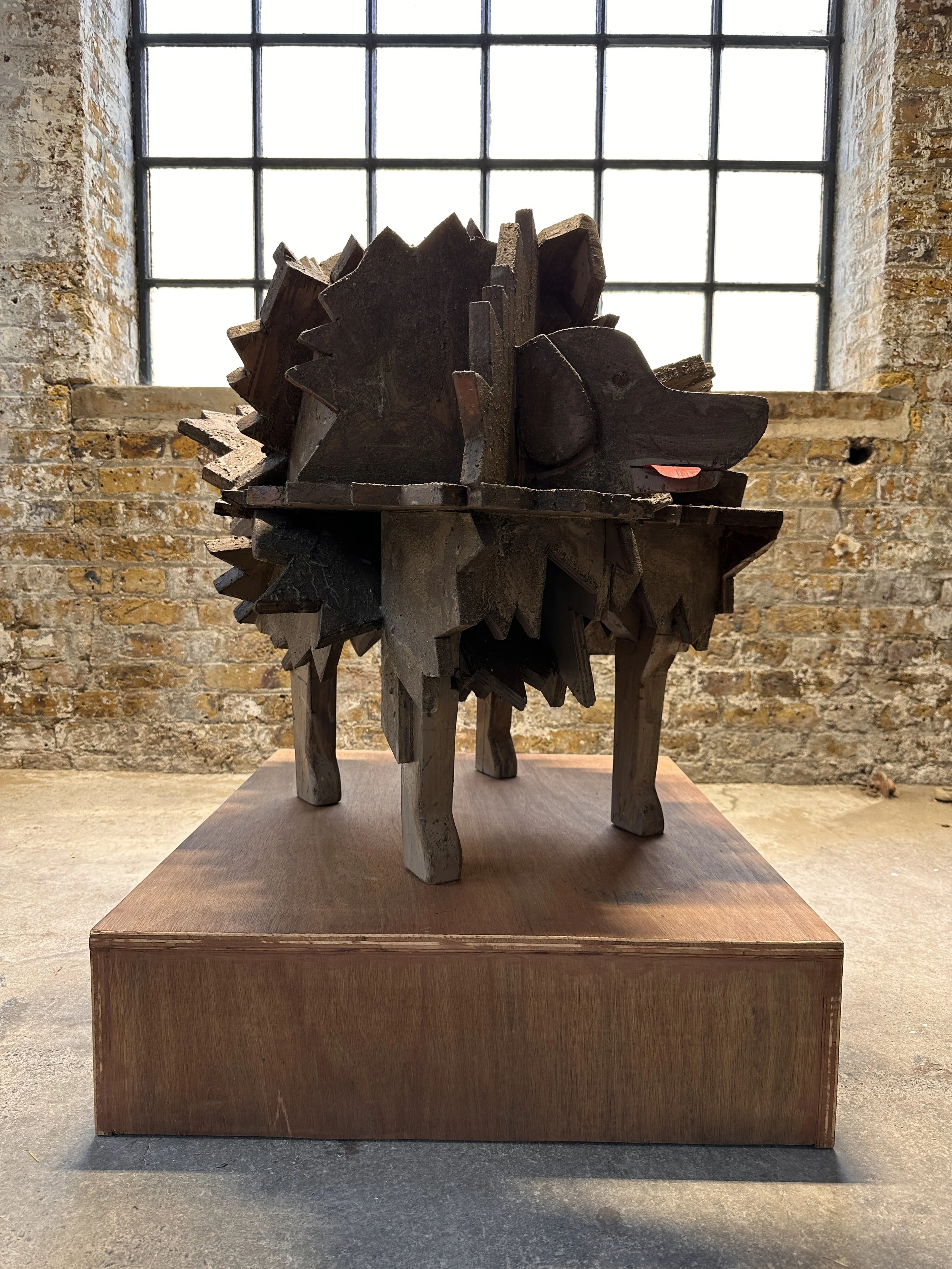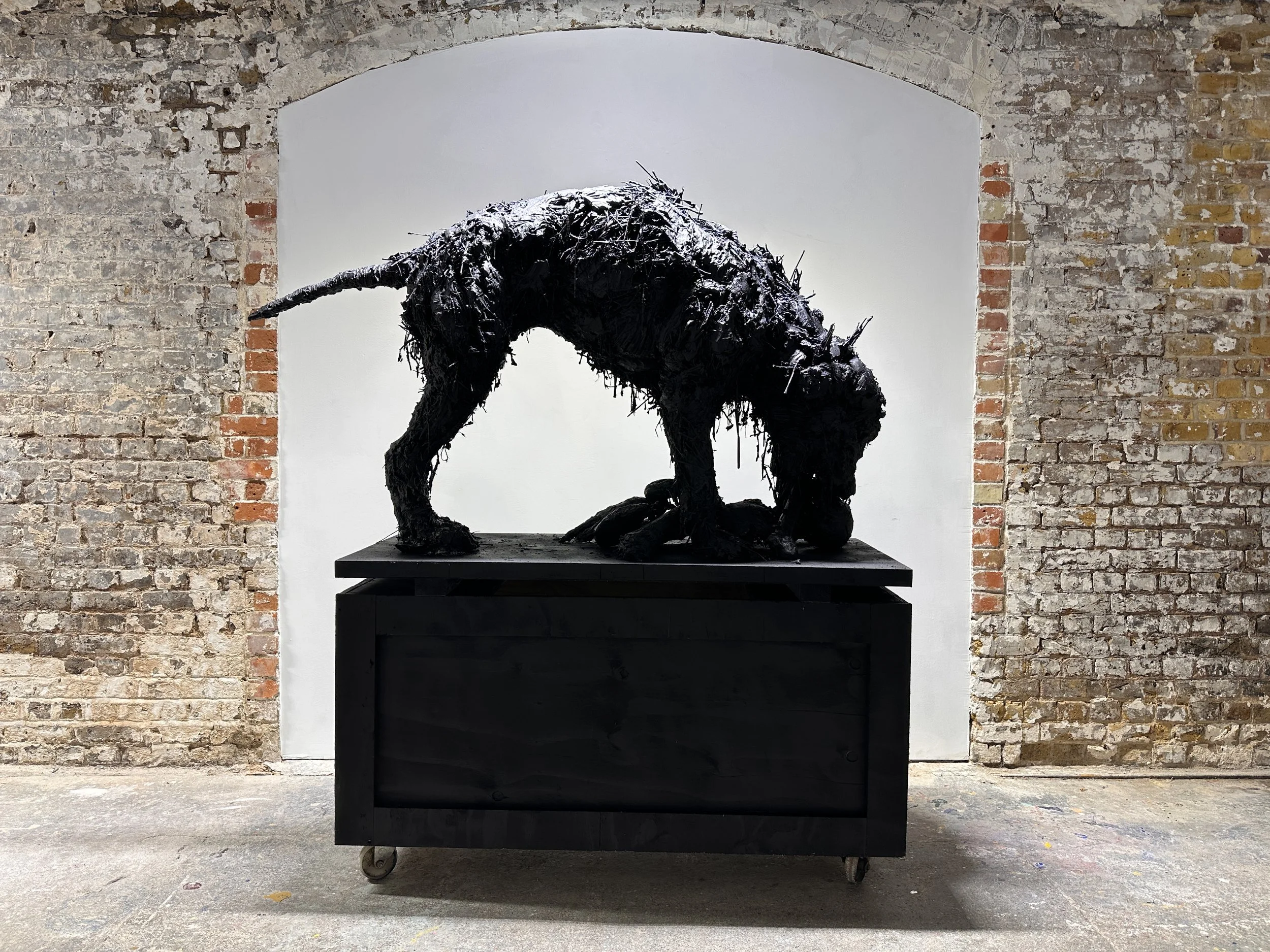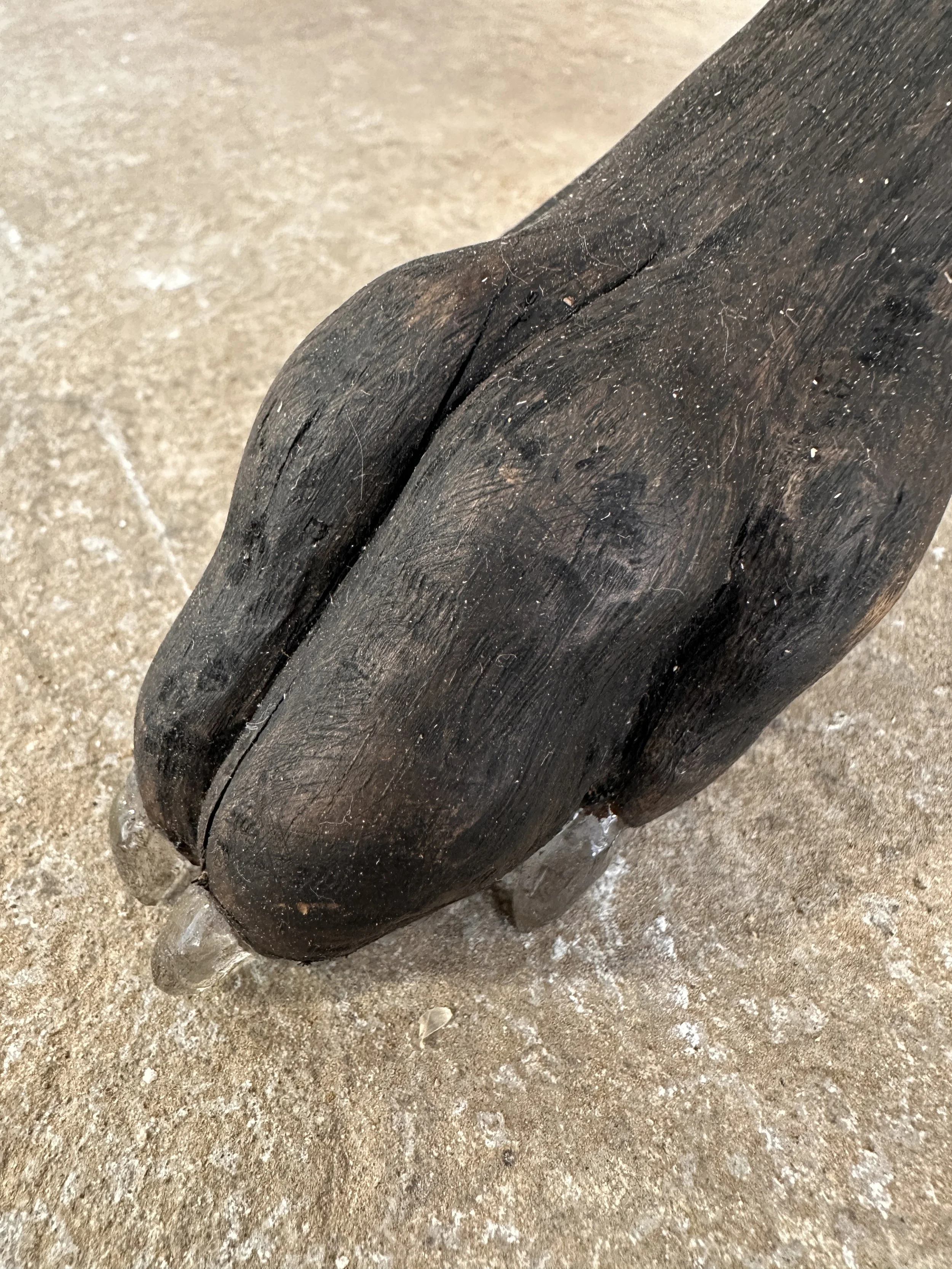
LOCATION: THE BOTTLE FACTORY
12 OSSORY ROAD, LONDON, SE1 5AN
7 AUGUST - 21 SEPTEMBER
Open Thursday - Saturday, 12noon - 5pm
+ Sunday 21 September, 12noon - 5pm
When we look into the eyes of a dog – tranquil or snarling – do we catch a glimpse of ourselves?
PEDIGREE is a group exhibition that examines how the domesticated dog reflects the instincts, structures and contradictions of human behaviour.
Dogs have long held a mirror to human nature. Domesticated over millennia, they have been shaped not just by evolution but by the desires, fears and fantasies of the people who live beside them. This exhibition explores the complex relationship between humans and dogs, where affection is often entangled with control, and loyalty with legacy.
The works on view consider how dogs, once wild predators, have been bred into symbols of comfort, status or sentiment. Through painting, sculpture and installation, the show reflects on themes of training, identity and transformation, asking how much of what we see in a dog is a projection of ourselves.
ARTISTS:
Lisa Ivory
Reece Jones
Eloise Peggy Knight
Jacopo Naccarato
Claire Partington
Irena Posner
Kit Reynolds
David Surman
Becky Tucker
Kristoffer Axén
Masha Barks
David Cooper
Samantha Fellows
Jacob Freeman
Michael Gao
Lee Grandjean
Nicola Hicks
Tulani Hlalo
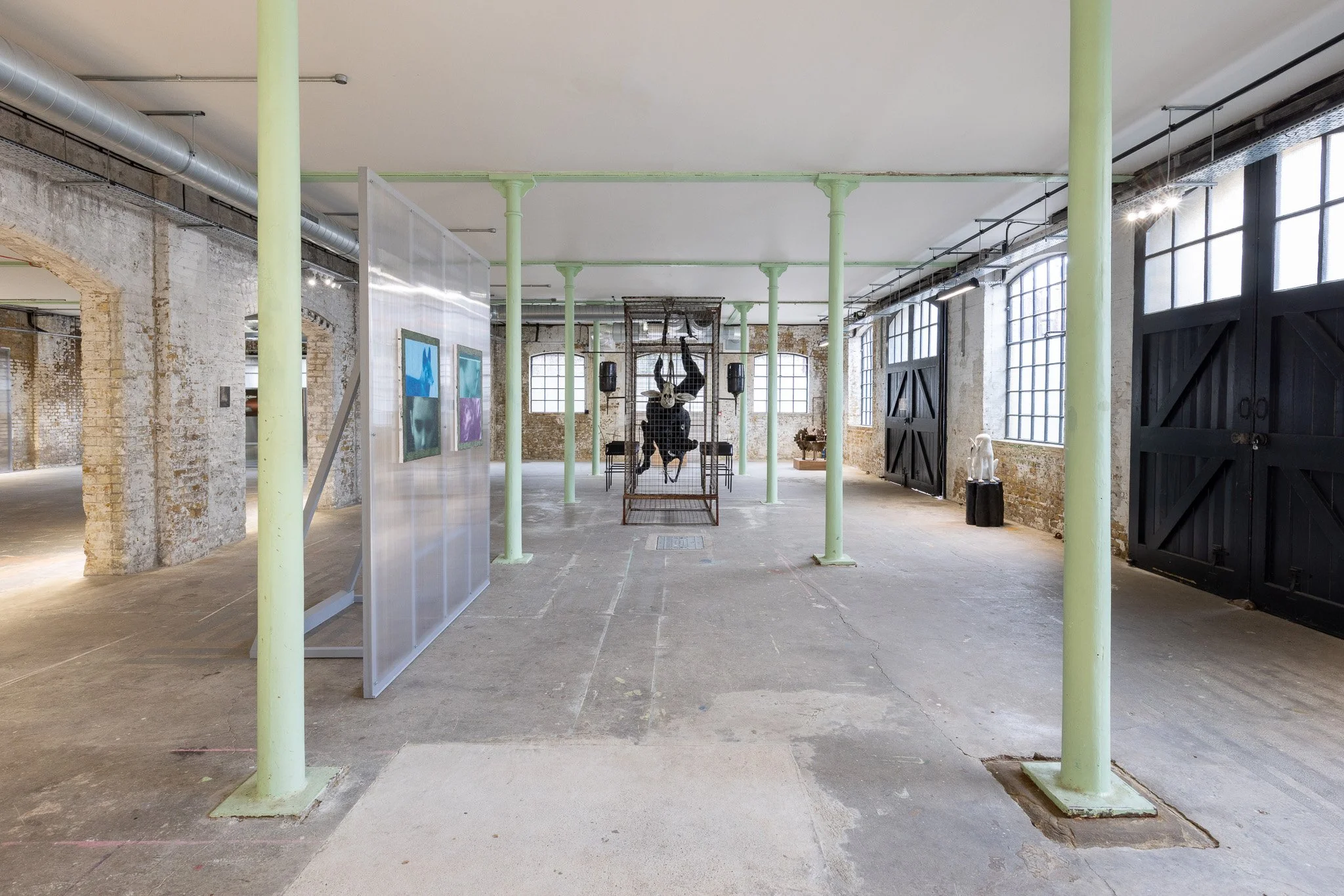
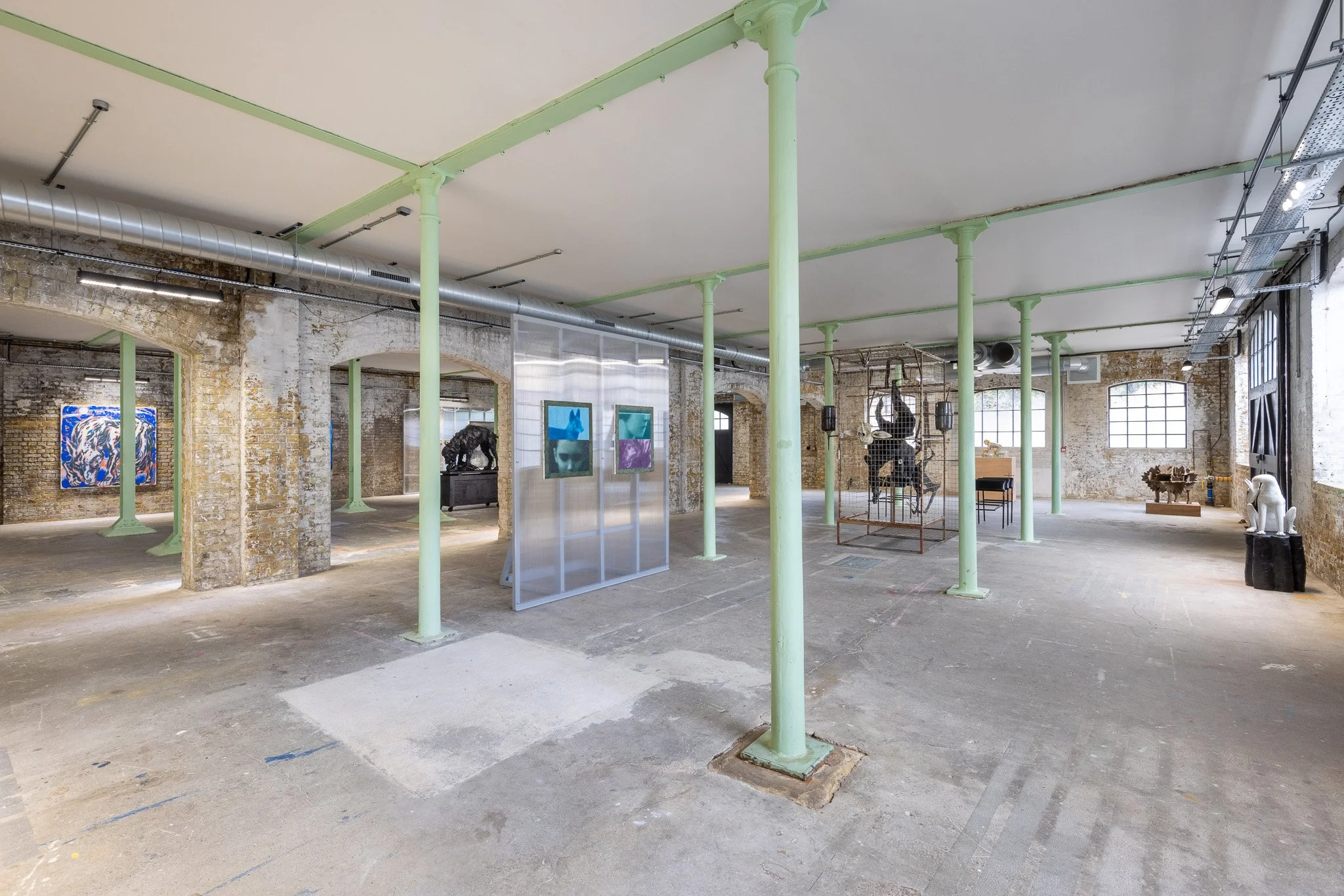
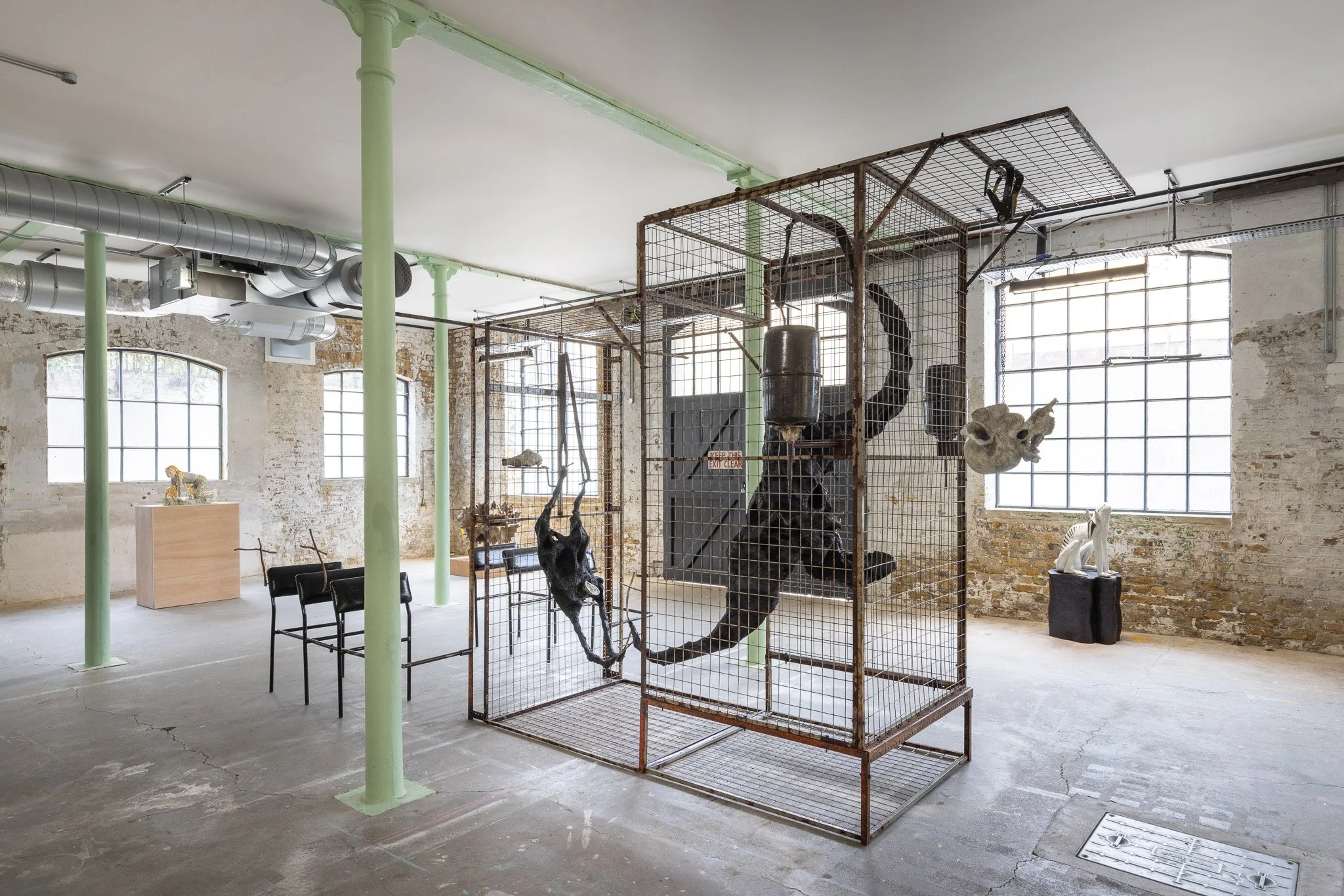
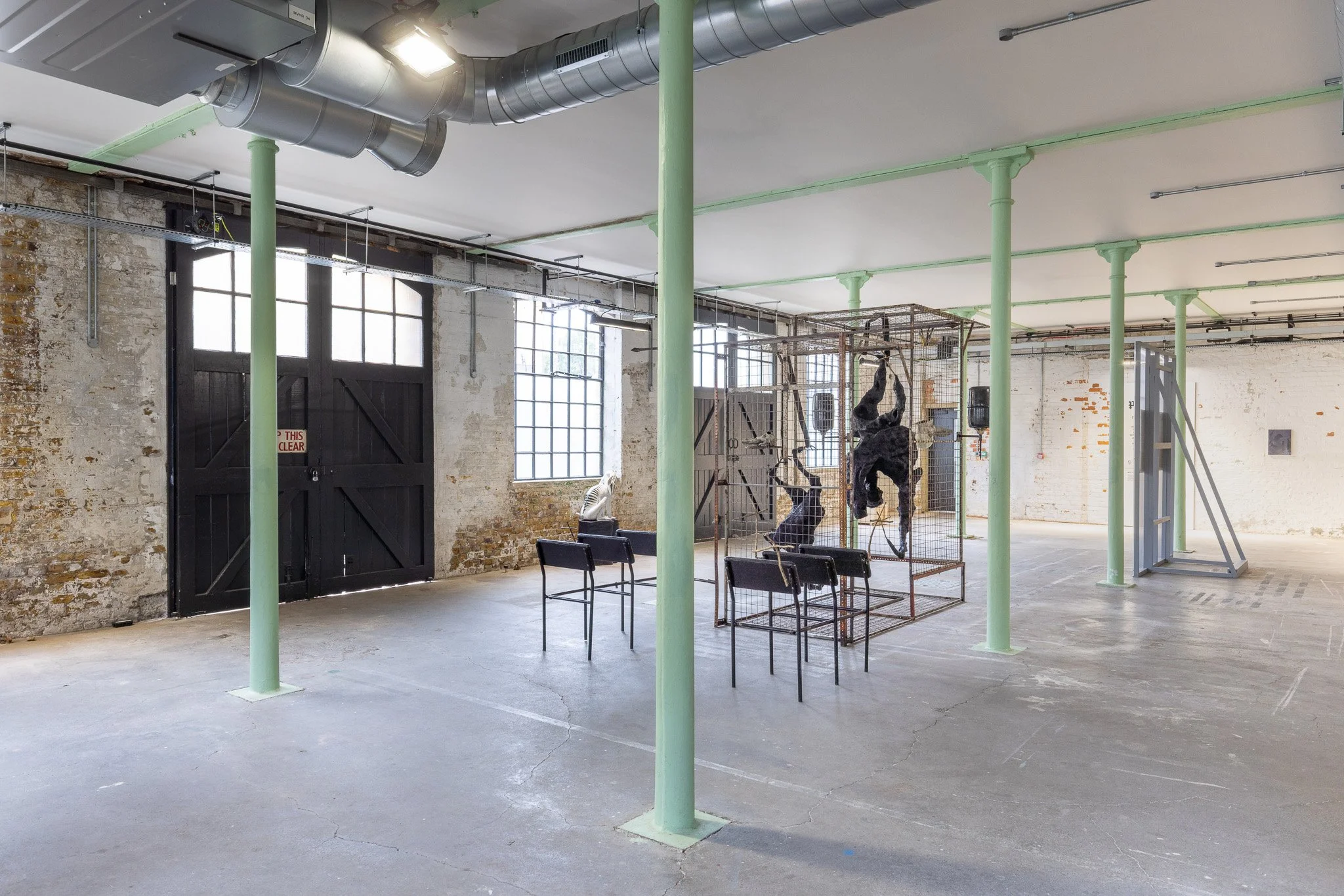
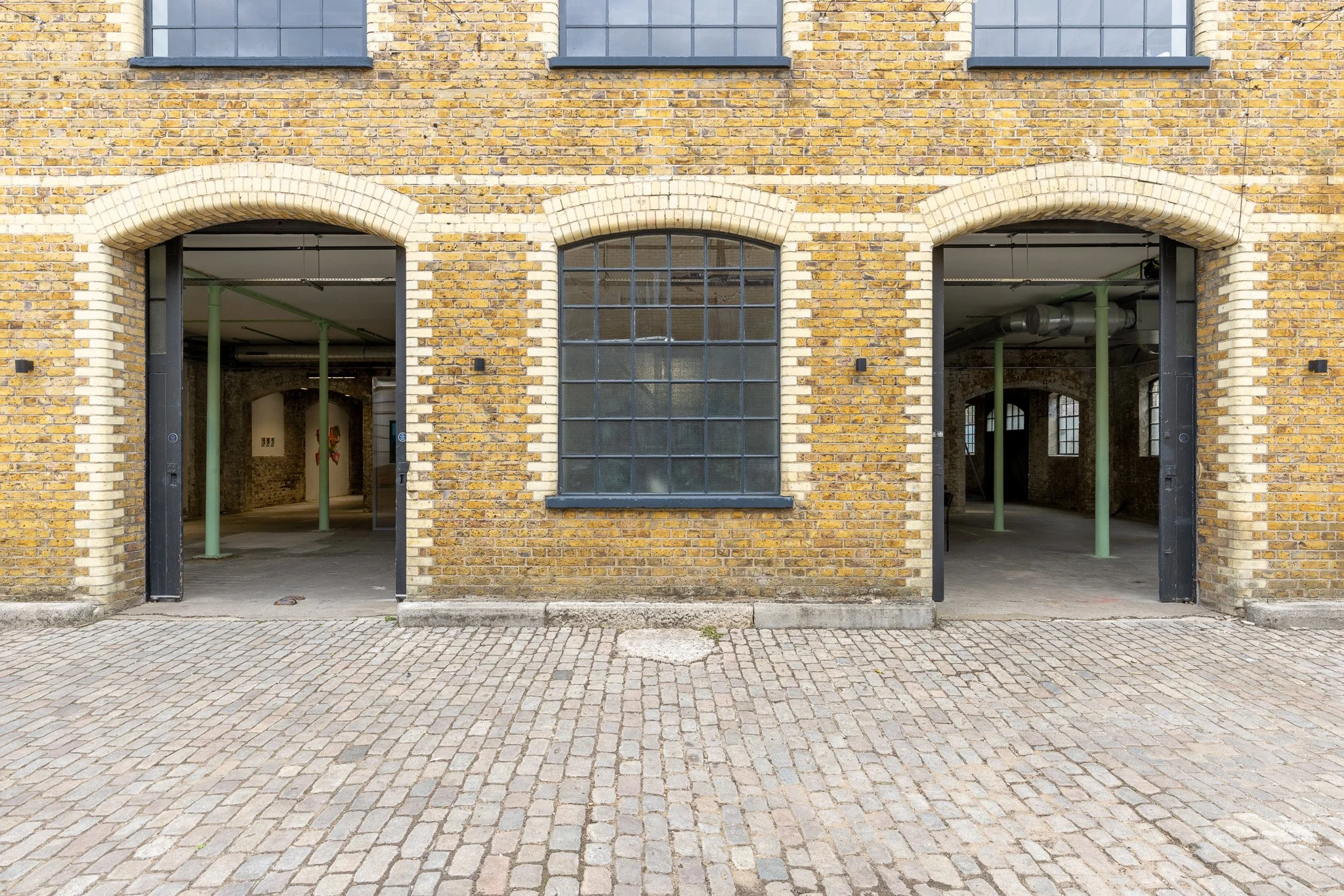
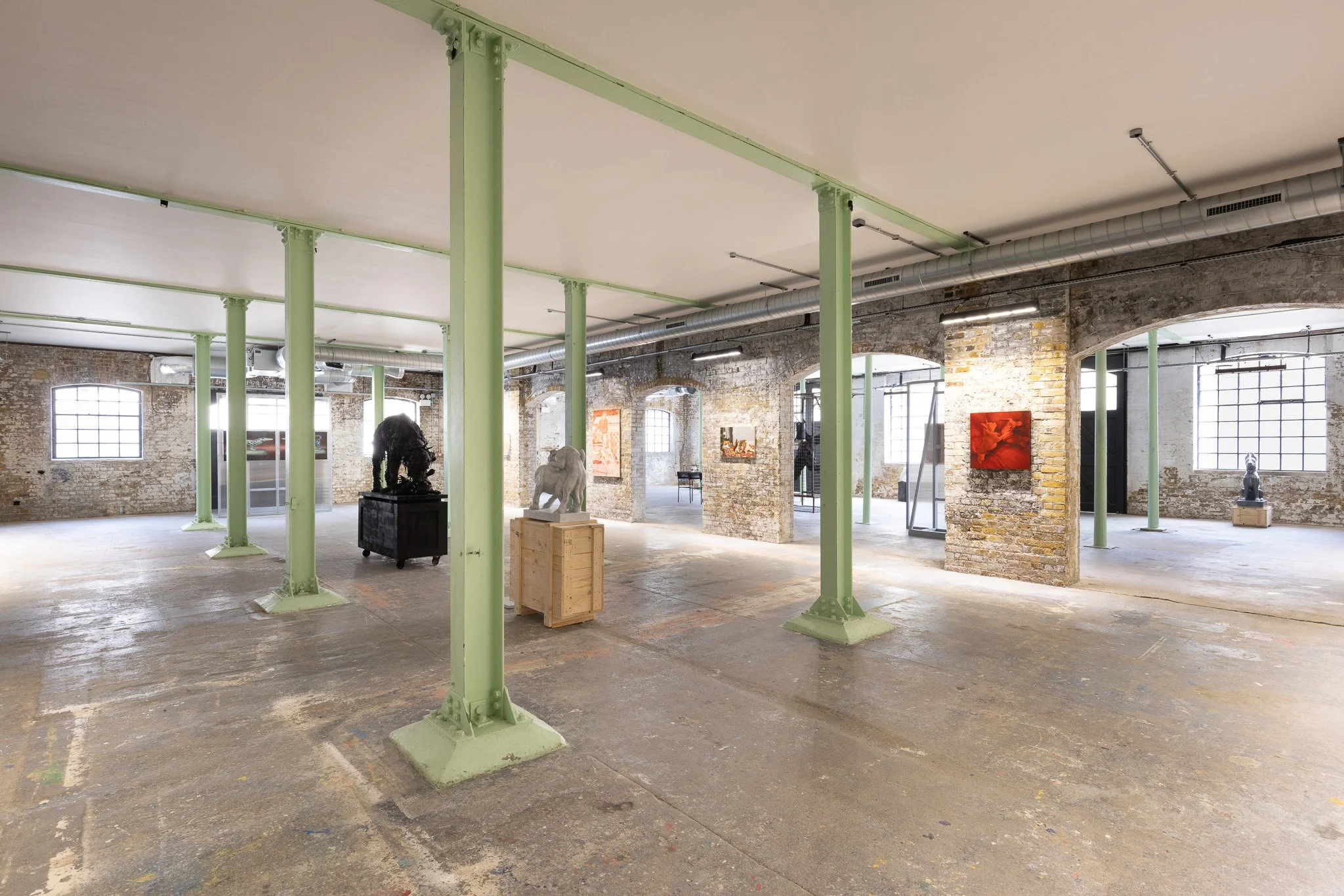
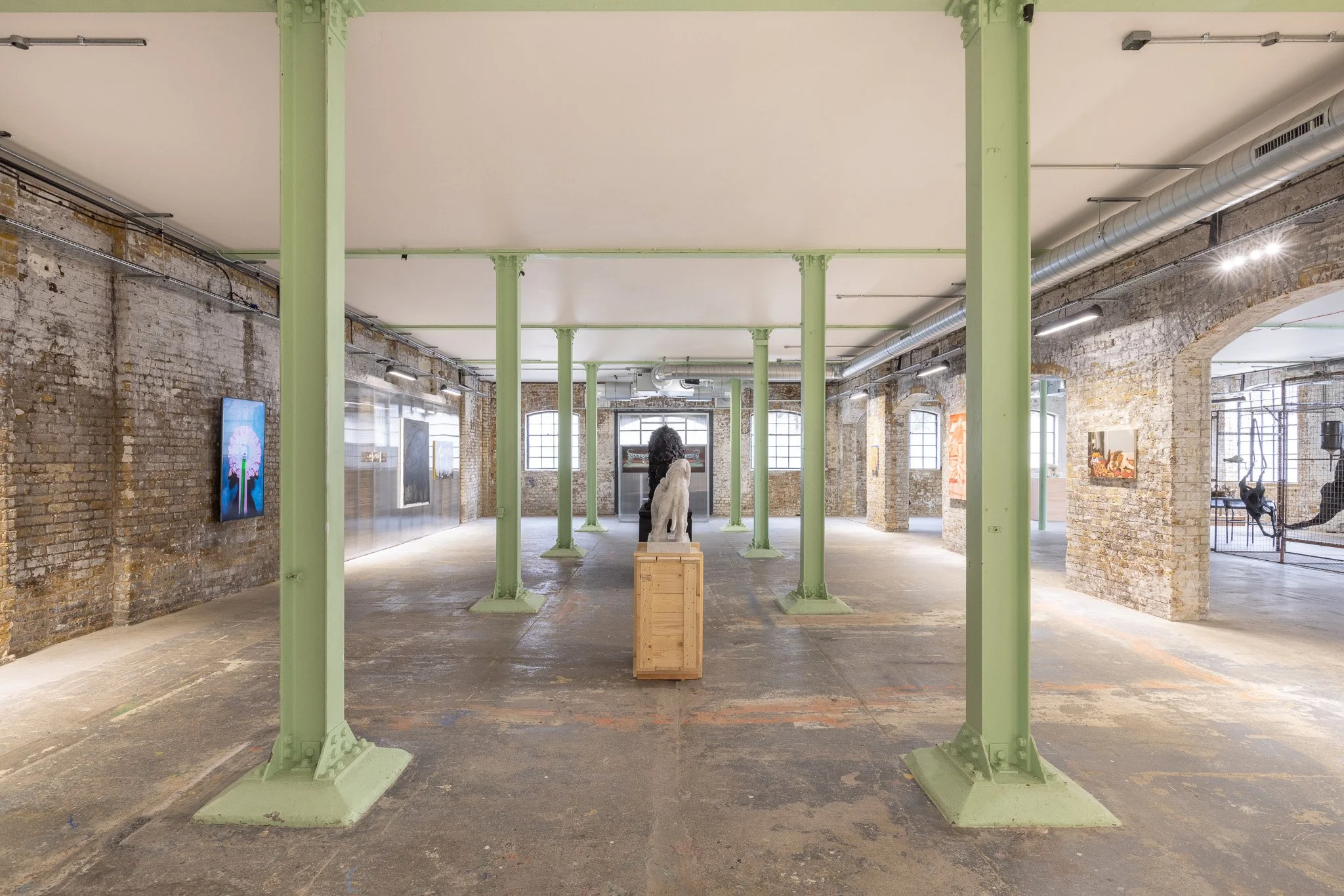
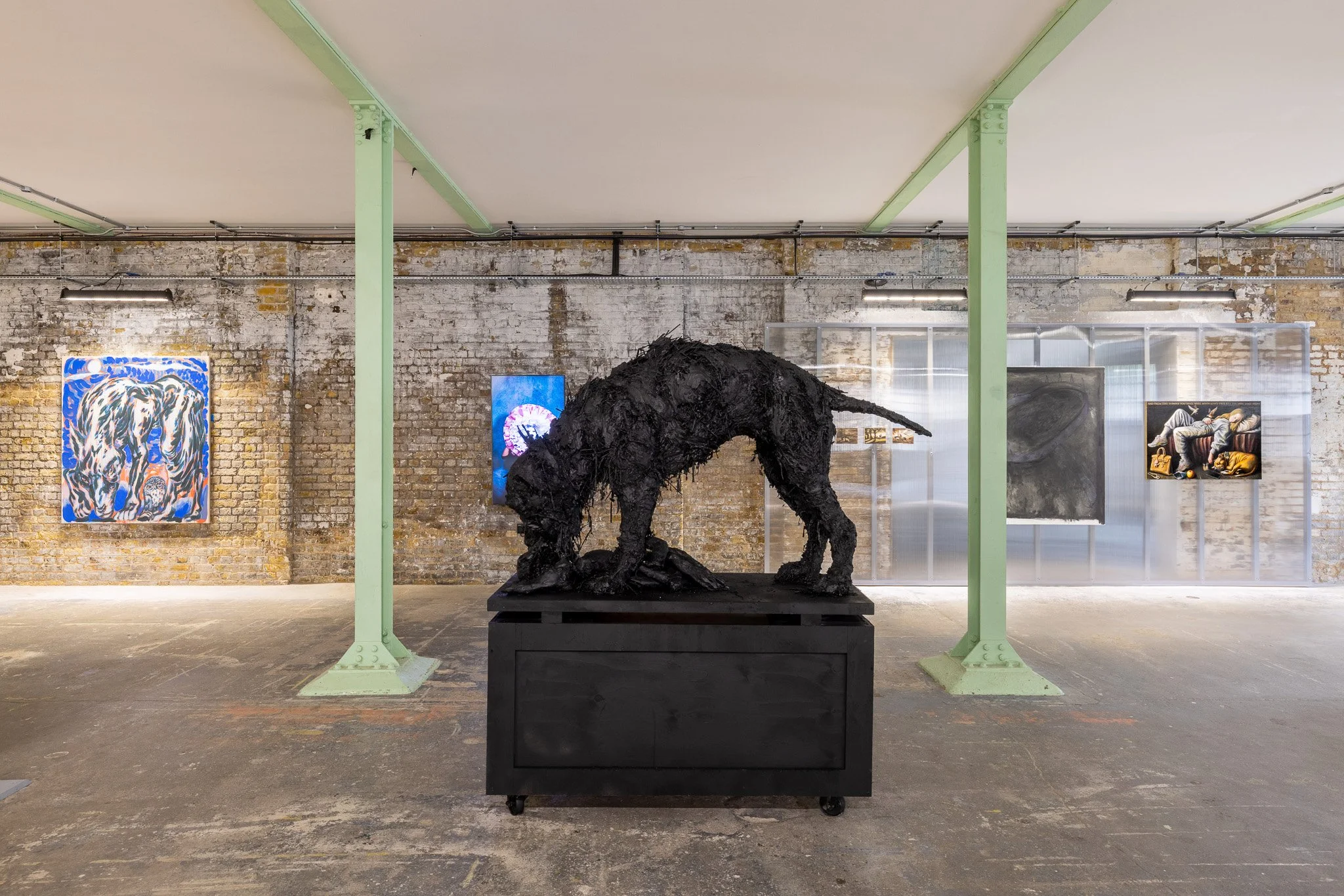
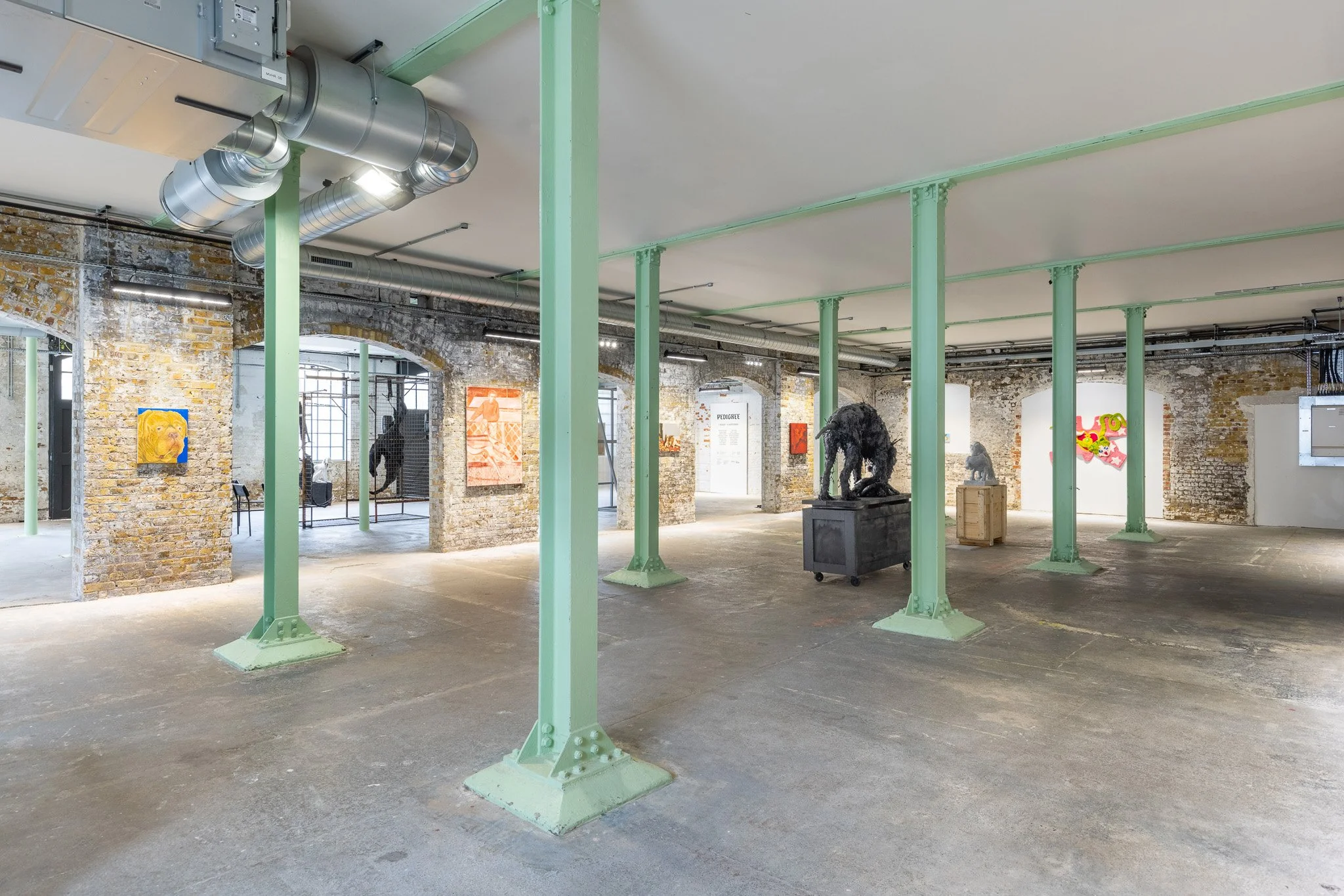
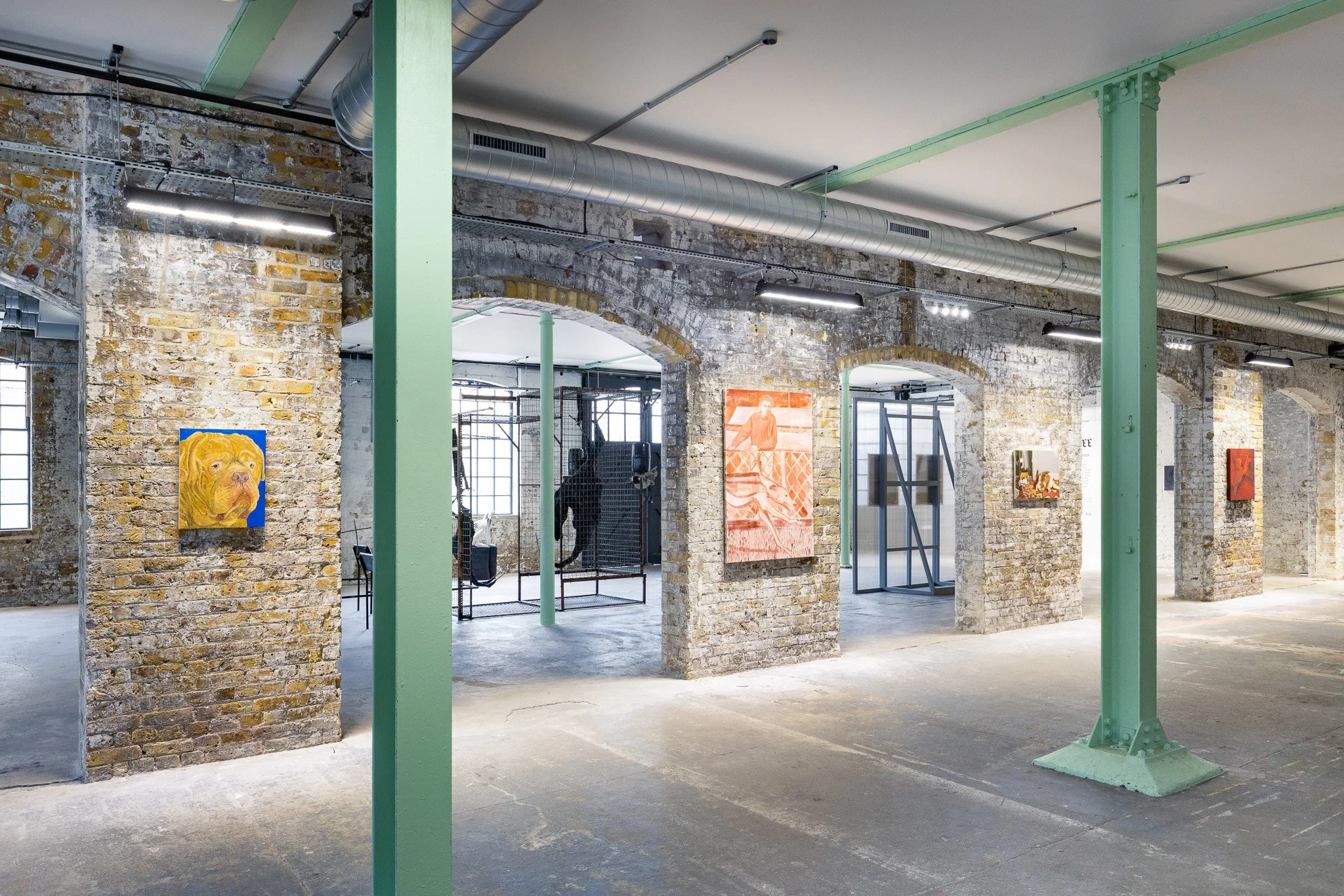
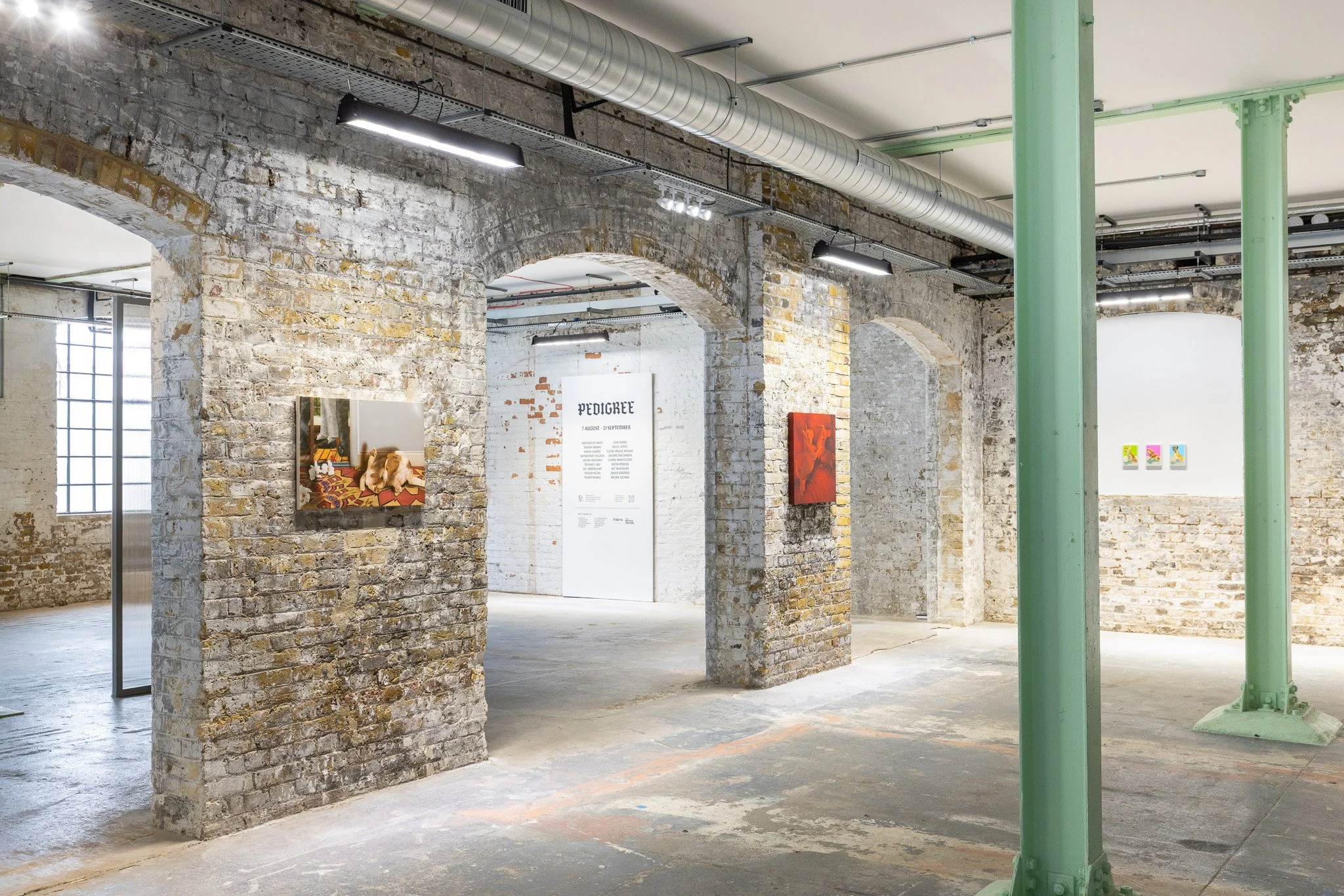
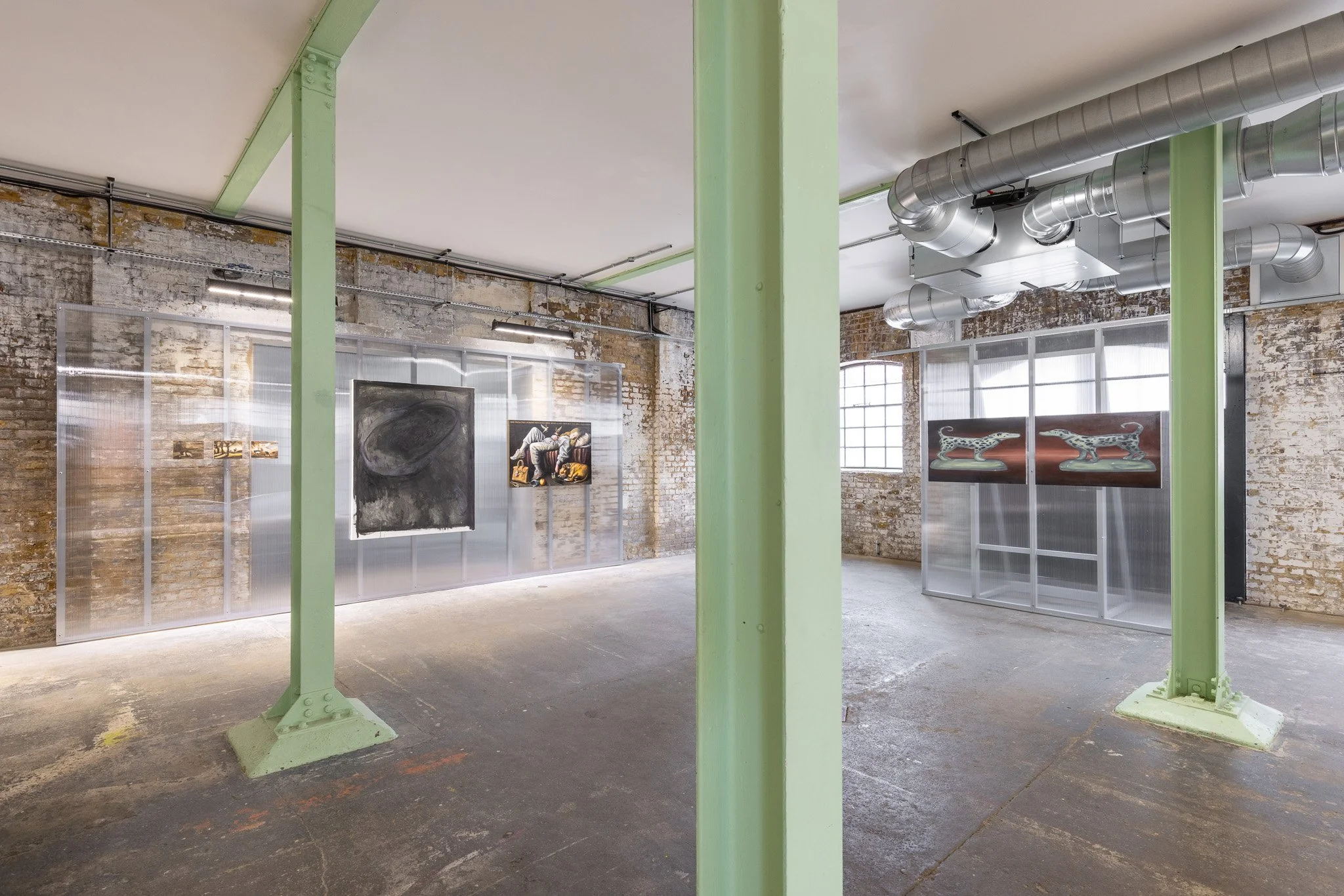
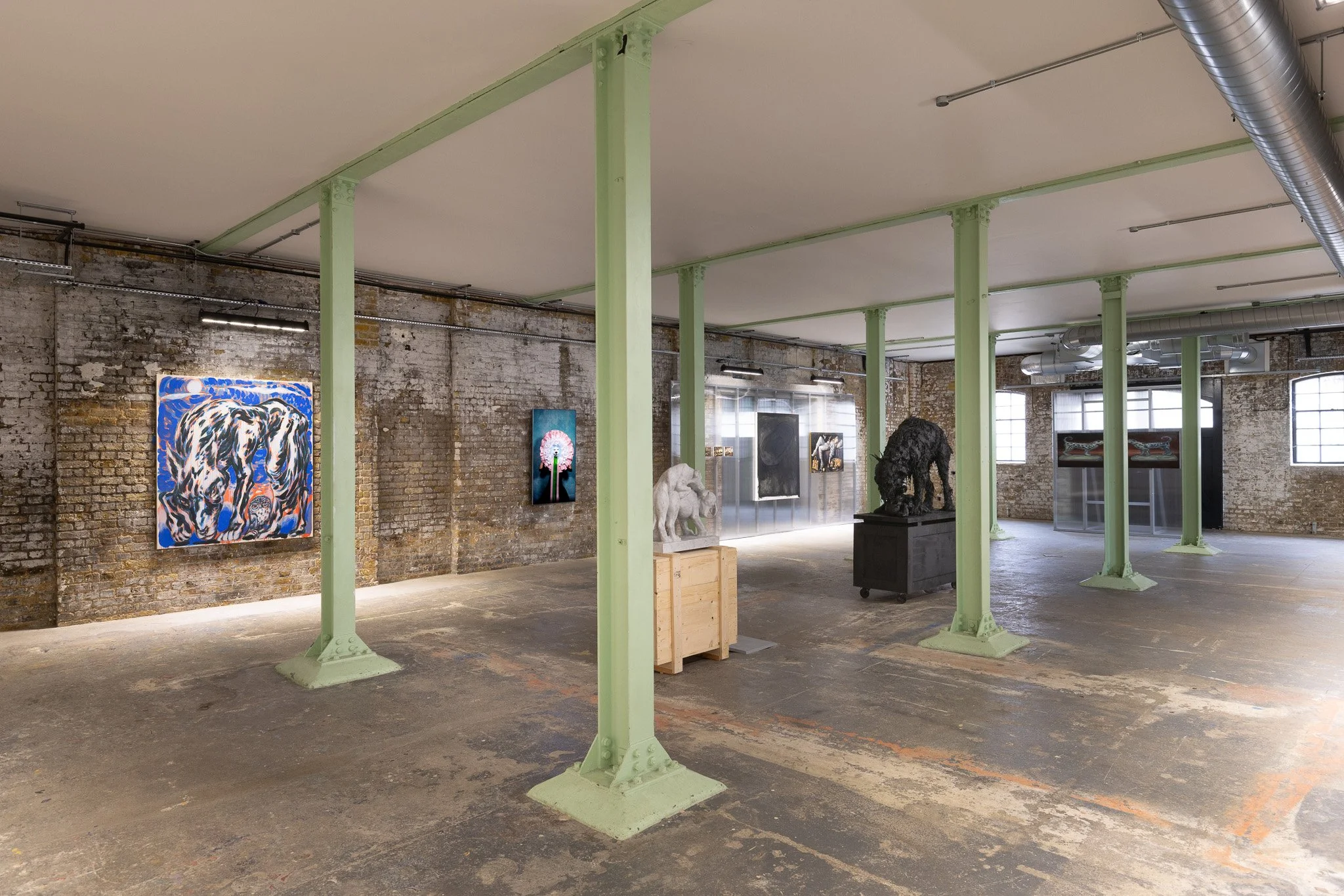
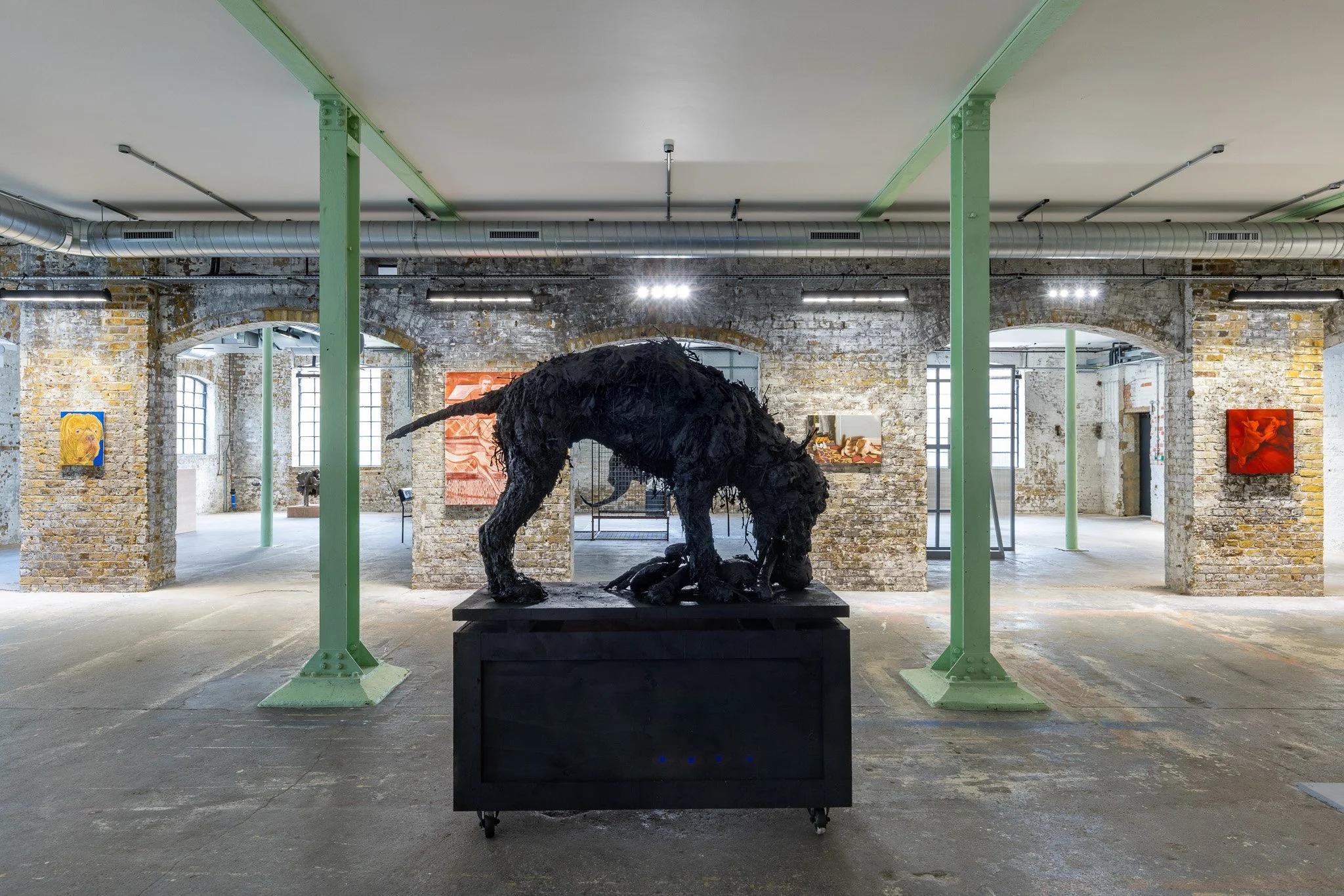
The story of domestication, from apex predator to pampered pet; is a story of power, manipulation and co-evolution. The very term pedigree speaks to a human obsession with lineage, purity, and classification. Through selective breeding and stylised training, dogs have been reshaped to fit our needs and neuroses, and in the process, their form becomes an expression of our own psychology.
The first work visitors encounter is Irena Posner’s Untitled (Doberman) — a finely carved marble dog held within a steel harness, poised in a state of controlled tension. Positioned elsewhere in the gallery, Dolce captures a pair of dogs mid-coupling, rendered with classical elegance. Together, these works reflect on how instinct, discipline and desire intersect in our shaping of animal bodies. Claire Partington continues this thread with
The Birth of Rome, a ceramic tableau in which two dogs appear attempting to feed on a female figure. Referencing mythology and folklore, the work subtly unsettles ideas of origin, loyalty and power within human–animal narratives.
The exhibition’s title also gestures toward ideals of purity and display — and the hidden suffering they can entail. Samantha Fellows and Eloise Peggy Knight both explore the sentimentalisation of dogs through porcelain representations. Fellows paints slick, pristine images of canine “collectibles” inspired by vintage cigarette cards — symbols of control, fragility, and inherited idealism. Knight’s larger canvases blur nostalgia with abstraction, distorting porcelain figurines into dreamlike vessels of memory and loss.
David Surman and Tulani Hlalo each explore how domestication functions as performance. Surman’s exuberant, pop-accented paintings engage the cult of cuteness — how we breed, stage, and depict dogs as emotionally controllable, infantilised creatures. In contrast, Hlalo draws from the niche world of competitive dog grooming, reimagining flattened pelts into colourful textile forms that interrogate how identity — both human and canine — is groomed, staged, and commodified.
Michael Gao offers a more unsettling perspective. Through his paintings, he explores social dynamics, identity, violence and desire, placing these themes in the ever-changing context of contemporary visual culture. In the work presented here, a dog contentedly licks itself on a richly patterned rug while, behind it, a trio of male legs suggests a social rupture — one figure appears confronted or encircled by two others. There’s no explicit violence, only the subtle staging of dominance, threat, or exclusion. The dog, indifferent to this charged human interaction, becomes a strange mirror: instinctively present, yet curiously disconnected from the drama we choreograph around it. Gao’s composition casts the animal as a counterpoint to human tension — a figure of primal detachment amid socially coded behaviour.
Lisa Ivory conjures wild men, chimeras and mythic beasts in her dreamlike worlds — evocations of fear and longing for the untamed. Her paintings suggest that even as we domesticate, we remain haunted by the wilderness we’ve never fully left behind. Nicola Hicks explores similar terrain in sculptural form. In War Dog, a monumental beast appears to vomit and consume simultaneously — a visceral embodiment of conflict, appetite and confusion. Hicks’s human–animal hybrids reveal the entanglement of violence and care, strength and vulnerability, in both species.





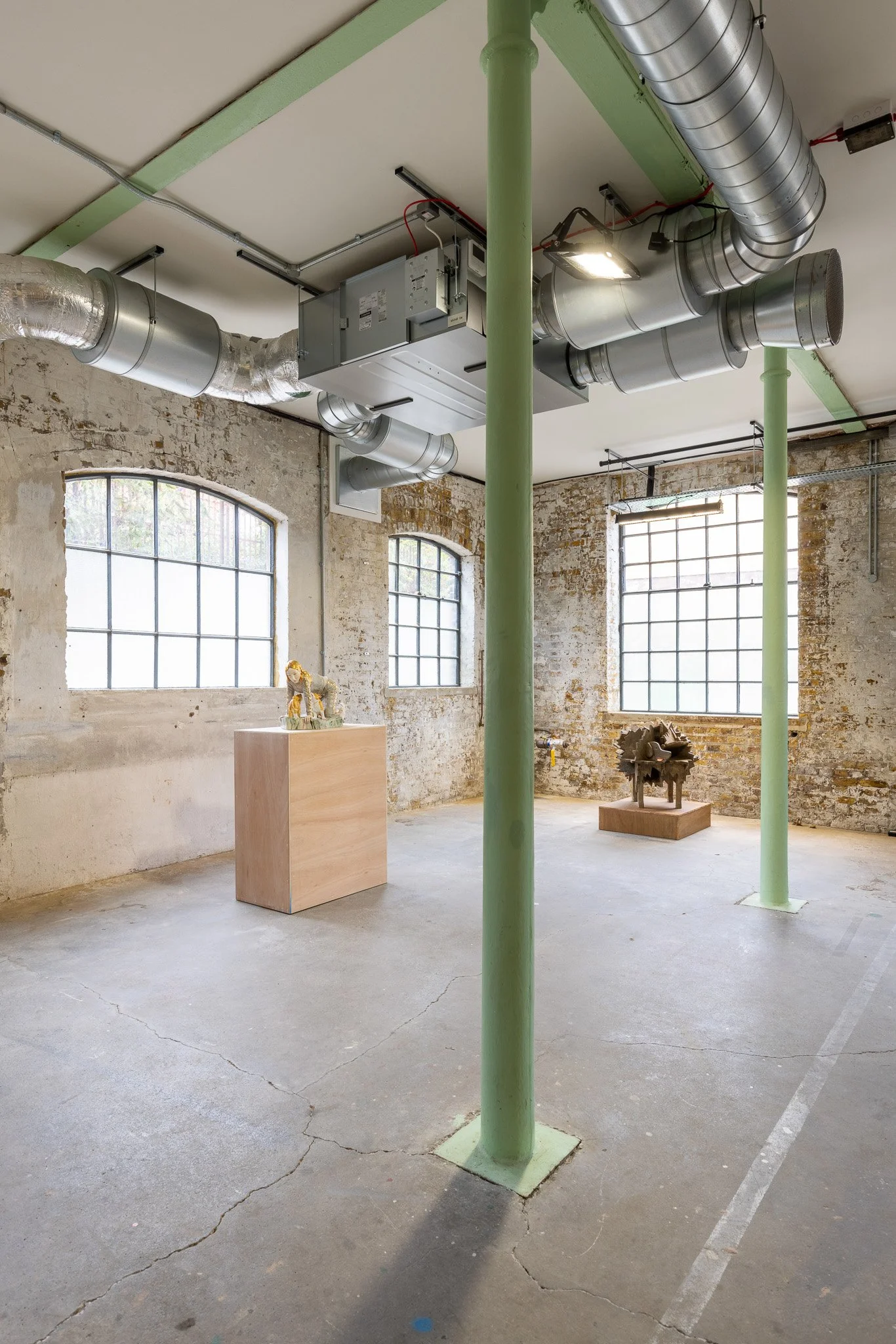












Jacopo Naccarato’s intuitive paintings and totemic objects hint at transformation without offering resolution — strange, hybrid forms that resist fixed meaning. Reece Jones approaches drawing and painting as sites of interpretive uncertainty. His fragmented images, sometimes resembling forensic evidence or cinematic stills, suggest shifting belief structures and the fragile nature of what we claim to see. His works linger between presence and absence, fact and fabrication — like glimpses of an animal that may or may not be there.
David Cooper’s sculptural installation NO DED channels deeply personal experience through feral, found-object assemblage. At its centre stands a large cage, inside which seemingly charred carcasses hang suspended, whilst a ghostly audience watches on. This stark image suggests that human nature itself may be a kind of containment, a caging of the beast within. Grief, restraint and survival converge in the work’s chaotic, fragile and instinct-driven form. It speaks to a state of being shaped by care, illness and the struggle to hold together what resists control. These emotions echo in Kristoffer Axén’s quiet, cinematic paintings, where figures and dogs drift through liminal spaces that feel both familiar and unreal. His work reflects on the melancholy of transience and the subtle weight of companionship.
Kit Reynolds and Jacob Freeman each interrogate cultural memory through image-making. Reynolds, working from archival and online material, explores how dogs signify desire, nationalism and domestic nostalgia — symbols that move between personal and political histories. Freeman’s painting practice is rooted in the joyful, chaotic remixing of pop culture, horror, and myth, where dogs surface as loyal companions and surreal avatars. Both artists use the dog as a mediator between fantasy and truth, critique and comfort.
Becky Tucker and Lee Grandjean bring this mediation into sculptural form. Tucker’s Pinna, referencing the anatomical structure of a dog’s ear, feels both bodily and alien — an imagined future relic that blurs the boundary between organism and object. Grandjean’s earthy, tactile sculpture Mud Dog Ruff embodies presence through material — a confrontation between form and instinct, surface and shadow. Together, their works speak to the physicality of the animal body, and its strange closeness to our own.
Finally, Masha Barks shifts the frame entirely. Her practice, blending virtual reality and painting, invites us to imagine a world seen through nonhuman eyes. In her playful yet critical compositions, dogs occupy domestic spaces with quiet assertiveness, unsettling our assumptions of hierarchy and control. Through her lens, empathy becomes multispecies — not an act of projection, but of repositioning.
PEDIGREE presents an inquiry into our most domesticated relationship. Across the works, the dog becomes more than a subject, it becomes a lens through which we examine our desires to love, to dominate, to memorialise, and to transcend. In turning wolves into lapdogs, we have not only reshaped the animal, we have revealed our human nature.


















THE ARTISTS:
-
Kristoffer Axén (b. 1984) in Stockholm, Sweden, is a self-taught painter who studied fine art at the International Center of Photography in New York between 2008–2009, a city in which he lived and worked until 2013. He was selected as a part of the New York–based 2011 Tierney Fellowship and also included in the 2010 reGeneration2: Tomorrow’s Photographers Today traveling exhibition, which has been shown in over a dozen countries worldwide. Axén’s work has been exhibited internationally, with solo exhibitions in New York (Munch Gallery), Copenhagen (Galerie Pi), Stockholm (Gallery Domeij), and most recently at the InCadaqués Festival in Spain (2024). His work has appeared in numerous group exhibitions, including Galerie Hors Champs (2024), Liljevalchs Spring Show in Stockholm, Aperture Gallery in New York, Photo London and Musée de l'Elysée in Lausanne, Switzerland. In 2024, he was selected as a Judge’s Pick in the OD Prize. His work is held in several private and public collections, including the ICP Collection, Michaelis School of Fine Arts, and MONA, and has been featured in publications such as the British Journal of Photography, The New York Times, and Vogue Italia. He currently lives and works in Stockholm, Sweden.
-
Masha Barks (b. 1998, Moscow) graduated with distinction in BA Fine Art from Goldsmiths, University of London, in 2022 and will begin her MA at Slade in September 2025. She completed the Turps Banana Residency in 2024 and is currently part of the art community at Conditions.
Working across painting, VR, and printmaking, Masha explores human-animal relationships through a playful yet critical lens. In her independent practice, she has focused on oil painting, drawing inspiration from posthumanism, queer studies, and internet culture. Her work decentralises the human perspective by placing everyday elements into unconventional contexts, challenging traditional ecological hierarchies while inspiring care that extends beyond the self.
Her work has been exhibited internationally across Austria, Germany, Switzerland, Russia, and the UK, with notable London exhibitions at One Paved Court Gallery and Willesden Gallery. Masha's practice extends beyond the studio through community engagement, including her role as art tutor with Unity Hub Ukraine in 2022, where she utilised art and animal therapy to support young refugees. She also collaborated with an animal shelter in Moscow in 2021 to provide dogs with new, experiential environments.
-
David Cooper (b.1972, UK) lives and works in Suffolk. His work deals with disorder, taking fragments of found, disregarded objects and exploring them inside-out, and outside-in, through a series of unpremeditated and intuitive processes in three-dimensional form. The works inquire into a humanity that feels, fears and confronts restriction and control; a state of being often conducive to an abominable sense of desolation and fettered anxiety. These unknown (and unknowable) aspects of the human condition, driven by momentary absences of restraint, stricture and control are embodied. Broken happenings, motivated by instinct, assemblage techniques and random thoughts, naivety and energy are exploited to sculpt the identity of these unfathomable aspects of human experience. Cooper studied fashion at John Moores University followed by an MA in Fashion Design at Central Saint Martins where he went on to become lead designer and head of menswear at Alexander McQueen. More recently Cooper attended Fine Art summer school at the Slade School of Fine Art in 2008. Works have been exhibited extensively in the UK including The Gilbert Bayes Award (2021) at Cromwell Place and most recently in a solo exhibition’War Hed’ at Anima Mundi, St Ives.
-
Samantha Fellows (b. 1971, USA) is concerned with capturing moments; the sense of a fleeting experience or memory, held indelibly in the swirling application of paint over a slick surface. In the act of painting, she carefully manoeuvres and slides translucent layers of oils over a glossy white ground of enamel, her goal is to disturb the slippery glazes of oily colour until the desired image and accompanying sense of something, is secured. Her focus is to present the souvenir of a sensation.
-
Jacob Freeman (b.1994) is a Canadian artist living and working in London, UK. Jacob graduated with a BFA from the University of Western Ontario, CAN, 2016 and recently completed his MFA at The Slade School of Fine Art, UK, 2025. Freeman’s practice is rooted in world building in which fantasy, personal narratives and popular culture intertwine. His work is equally concerned with a material investigation of paint and the joy of making. His practice is fueled by his personal collection of found images sourced from magazine archives, movie stills and fan-page boards. Concerned with the mediation between source image and painting, his works delve into sites of transformation within the natural world and an exploration between the relationship of fantasy and reality within the horror genre. Jacob has recently shown with Hew Hood Gallery, London UK, RAINRAIN Gallery, New York City, USA and Abbozzo Gallery, Toronto, CA.
-
Michael Gao (b. 2002, Beijing, China) is a Chinese painter currently living in London. Through his paintings, he explores social dynamics, identity, violence and desire, placing these themes in the ever-changing context of contemporary visual culture. In his most recent series, Gao creates a fantasy realm where desire unfolds through the presence of hybrid creatures - creatures that are somewhere between human and animal. His work delves into this tension, where the boundaries between humans and other species are blurred in order to transcend human limitations or gain evolutionary advantages. His practice references ancient ritual traditions of metamorphosis, such as donning animal skins to gain animal abilities, while inviting viewers to consider desire as a primal drive - a force at the heart of survival that can evoke both pleasure and fear, cuteness and grotesqueness. Using animal and human imagery, Gao reimagines carnival as a post-internet space. This setting further deepens the contrast between reality and fantasy, the familiar and the alien. He uses fine airbrush techniques combined with loose oil brushstrokes to create realistic yet surreal compositions, flattening the space to evoke a sense of claustrophobia, reflecting the tension and oppression inherent in digital space. In this series of works, the carnival world becomes a lens to explore how desire has become performative and ritualistic in the Internet age - it can both connect people and isolate them, both elevate and constrain them.
-
(b. 1949, United Kingdom) lives and works in Norfolk, and describes the sculpture he makes as a body-to-body meeting between viewer and object. Over the last forty-five years, Lee Grandjean has produced a body of work that is startling in its diversity and innovative in its approach. Grandjean remains to this day an important outlier in British sculpture: eschewing the prevailing tendencies of British abstraction and the ‘Age of Iron’; instead embracing a way of working that develops in tandem with painting, and foregrounds both subject and subjectivity. Grandjean studied at the Winchester School of Art from 1968 to 1971 and the North East London Polytechnic from 1967 to 1968. Grandjean has been exhibited in the Yorkshire Sculpture Park, Hayward Gallery, the Barbican, Flowers Gallery, Clifford Chance Gallery, and Djanogly Gallery. He is included in notable national collections including the Blenheim Group and Clifford Chance. Grandjean is well respected and has been included in numerous publications, including ArtReview, since 1981.
-
Nicola Hicks MBE FRSS (b. 1960, London) studied at Chelsea School of Art (1979-1982), before gaining an MA from the Royal College of Art, London, in 1985. Hicks defied the dominance of abstract art in the 1980s, forging a path centred on figuration and raw natural beauty. Working mainly with plaster and straw, her final sculptures are cast in bronze – the contrast between the materials used to construct the maquettes with the solidity and permanence of bronze imbuing the work with a simultaneous feeling of fragility and strength. Hicks is unafraid of exploring darker content in her work, and her often monumental sculptures routinely use anthropomorphism to raise questions about human and animal nature, depicting humanised animals and beast-like humans. ‘I love the magical feeling of having something evolve at my fingertips’, she says; ‘making something live that hasn’t lived before’. Hicks’ work features in prestigious collections and public spaces worldwide, including the Yale Center for British Art, New Haven, and Battersea Park and the Tate Gallery in London. She was awarded an MBE in 1995 for her contribution to the arts, and was elected a fellow of the Royal Society of Sculptors in 2023. Hicks lives and works in London.
-
Tulani Hlalo (b.1994, Newcastle upon Tyne) is based in Glasgow and works primarily with textiles, sculpture and video. Through costume, performativity and the absurd, her practice examines and explores ‘how identities are staged, constructed and performed within social, cultural and racial categories that inform our subjectivities.’ Hlalo’s recent bodies of work borrow from the niche subculture of competitive dog grooming as a visual language to explore how identity is at once defined and changeable. Employing playfulness and humour, as well as bizarre or otherwise unconventional imagery, her research examines a search for one’s sense of belonging and explores what it might mean to exist between cultures. Recent exhibitions include: Silly Bitch, SOUP, (London, U.K.), Eyes on the Prize?, Slugtown (Newcastle Upon Tyne, UK), The Sound of A Falling Tree, TUESDAY TO FRIDAY (Valencia, ESP), Extreme Competitive, ALMANAC Inn (Turin, IT).
-
Lisa Ivory (b. 1966, UK) lives and works in London, UK. Ivory graduated from St Martins School of Art with a B.A. (Hons) in Fine Art (Painting) in 1988. Ivory explores the concept of otherness and its inherent duality of fear and attraction. She creates fantastic worlds of mythical creatures, referencing wild men, chimeras, hybrids, anomalies, spectres and other classical narrative archetypes. She has recently shown with Nino Mier at the Brussels Art Fair, Veta, Madrid, Fabian Lang Gallery, Zurich, a solo show with CZA, Milan and a solo show with Pamela Salisbury, New York.
-
Reece Jones (b. 1976) lives and works in Suffolk, UK. In recent years, what had become a well honed, process led approach to making labour intensive drawings has shifted to a growing body of paintings on paper, board, canvas and panel, ranging from light, layered washes to built arrangements. Some are iterations on specific themes such as costumed hands reaching into space - (a viewer’s POV, the audience complicit). Some are riffs on found images from film, documentary or his own archive of historic work. They focus on formal relationships and the luminosity of various layers of paint, but also (crucially) on the elasticity of their potential interpretation. They may be rhetorical (text paintings) or iconic, or they may be the origin of something which will slide into interpretive complexity.
Reece studied at the Royal Academy Schools and was one of the founders and curators of the Rockwell project space in Hackney. He writes and curates occasionally. He is a lecturer in Fine Art at City & Guilds of London Art School, an Associate Lecturer in Fine Art at Anglia Ruskin University and runs a program of bespoke, critical, close viewing sessions for artists in their studios.
Exhibitions include, Cultuurhuis de Warande, (Turnhout, Belgium), The John Moores Prize For Painting (Liverpool), Andrew Mummery Gallery (London), Long Story Short (New York), The Drawing Room (London), Norwich Castle Museum, Voorkamer (Lier, Belgium), Tokyo Wonder Site, Transition (London), The Royal Academy (London), The Royal West of England Academy (Bristol), All Visual Arts (London) Paul Stolper Gallery (London) and Stephane Simoens (Knokke, Belgium).
-
Eloise Knight (b.1999, UK) explores nostalgia, memory, and the passage of time through the lens of antiques and sentimental objects. Drawing inspiration from the delicate porcelain animals, Knight examines the way these seemingly ordinary figures become vessels for personal and collective memory. Her paintings reflects on the shifting nature of recollection, where once-clear moments blur and transform over time. Through distortion, abstraction, and fragmented compositions, she reimagines familiar objects, mirroring the way nostalgia can be both vivid and elusive. By manipulating perspective and form, Knight captures the tension between permanence and impermanence, questioning how objects anchor us to the past while memories fade and evolve. Knight’s work invites viewers to reflect on their own relationship with sentimentality, family history, and the ways in which material objects preserve yet distort personal narratives. Through this exploration, she highlights the fragile balance between remembering and forgetting, creating pieces that feel at once intimate and universal.
-
Jacopo Naccarato (b. 1995, Arezzo, Italy) works with the purpose to ask the right questions, rather than give absolute answers. The process implies a solid start, beliefs that are innate or absorbed over time, that are systematically deconstructed and doubted. Frequently his focus is put on the figure, on the individual as a unique being, perfect in his flaws. He doesn’t make logical explanations, he’d rather penetrate into enigmatic terrains that need to be lived in order to assimilate and comprehend them – an individual comprehension, not a universal one. “The absence of a dream is not a misunderstanding, the enigma is the language of wisdom, surprise is an emotion”. By practicing the art of sculpture and painting, he adopts an intuitive approach, with the hopeful aim of generating new subjects, new shapes.
-
Claire Partington (b. 1973, UK) is an artist who revels in her historical influences. Golden age Spanish portraiture, 18th century salt glaze bears, Renaissance madonnas and medieval pilgrim badges: Claire dips in and out of each like a magpie, mixing them together with 21st century references to create exquisite ceramic sculptures. With striking presence, Claire’s works embody an enthusiasm for aesthetic objects and movements that sweeps across the centuries.
Partington graduated from Central Saint Martins in 1995 with a 1st in Fine Art Sculpture and gained a Post Graduate qualification in Museum Studies in 2000. Her work features in notable international collections including the Victoria & Albert Museum in London; the Museum of London; the Seattle Art Museum; the Ömer Koç Collection in Turkey, and the Reyden Weiss Collection in Germany. She was the recipient of the Virginia A Groot award in 2018, and the same year exhibited an important large-scale commission ‘Taking Tea’ at Seattle Art Museum. In 2020, her work was exhibited in ‘Cranach: Artist and Innovator’ at Compton Verney in Warwickshire, organised in association with the National Gallery in London. In 2022, she was commissioned by the Walker Art Gallery, Liverpool with the support of the Contemporary Art Society to produce a solo institutional exhibition ‘Claire Partington at the Walker’ and a site specific installation ‘what is a wealthy merchant’s house made of?’, which remains on permanent display.
-
Irena Posner (b.1988, UK) is a British artist who works across multiple mediums including sculpture, installation, painting. Posner holds a Masters in Sculpture from the Royal College of Art. She was awarded the Harlow Sculpture Town Artist in Residence for 2023 and was the recipient of the Gilbert Bayes Sculpture Award in 2021. She was shortlisted for the Kenneth Armitage Award in 2022 and has undertaken residencies in Carrara, Italy and Weymouth, England, and most recently completed a 6-month carving residency at the University of East London. Her works are held in Odunpazari Modern Museum, Turkey and Fondazione Benetton, Italy. Irena works between Carrara and London. Posner’s works enter the realm of allegory, playfulness and humour to explore power structures through animal discourses, selective breeding and fetish.
-
Kit Reynolds (b. 2000, UK) is a British artist based in London. Preoccupied with questions of social history, his paintings explore themes desire, consumption and the tangled legacies of industrialism and empire. Taking cue from material found across archives and social media, Reynolds probes images for their cultural signification, exploring the tensions between the banal and the historic, gravity and humour. By examining cultures of consumption and the mechanisms of desire that inform them, Reynolds aims to draw out and reevaluate the factors that inform national and personal identities.
Reynolds graduated from City and Guilds BA in 2022 with a BA in Fine Art, and has subsequently completed a postgraduate degree in Cultural, Intellectual, and Visual History at the Warburg Institute. He has participated in a residencies at Post-Ex Studio in Rome, DDD Kunthouse in Yerevan and Esedra in Siena and exhibits in shows across the UK and Europe.
-
David Surman (b. 1981) is a British artist based in London. He has established an international reputation in contemporary art for his paintings exploring the conventions and boundaries of figuration. He has developed a contemporary language embracing and fusing gestural expression, a knowledge of art history and pop-cultural aesthetics such as cuteness. He is a graduate of the animation programme at the Newport Film School (2002) and the postgraduate film studies programme at Warwick University (2004). Recent solo exhibitions include 'After The Flood' Rebecca Hosssack Art Gallery (2025), ‘Sleepless Moon’ Gallery THEO (2024) Seoul, ‘Portraits of a Wild Family’ Sens Gallery (2022) Hong Kong, ‘Fairy Painting’ Sim Smith (2021) London, and ‘Sirens’ (2019) also at Sim Smith. His work is held in several major public and private collections, including the UK Arts Council Collection, The McEvoy Foundation for the Arts, the Neumann Family collection, the Hornik Collection, Colección ALKAR Arriola Zugaza and Colección Espinosa de los Monteros Sáinz de Vicuña.
-
Becky Tucker (b. 1993) lives and works in Glasgow. Recent solo exhibitions include ‘The Quarry’, Fabian Lang Gallery, Zurich, ‘Umbra’, Steve Turner Gallery, Los Angeles and ‘Arca’ Five Years Archway, London. Her work has been exhibited in group shows internationally. She has received funding for research, development and production from the Creative Scotland Individual fund, the VACMA bursary scheme and the Hope Scott Trust. In 2023 she was selected for the Inaugural edition of the GIRLPOWER residency, France, followed by being artist in residence at Sanctuary Slimane, Morocco. Tucker’s sculptural practice explores duality and storytelling through making objects from an imagined history or future. Themes of opposition and mimicry are a recurring language in her work, repeatedly creating objects that reference the human or animal body, blurring the line between animate character and object.





